|
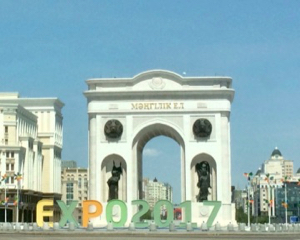 |
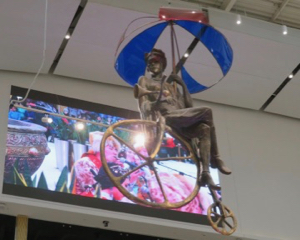 |
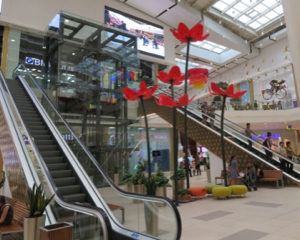 |
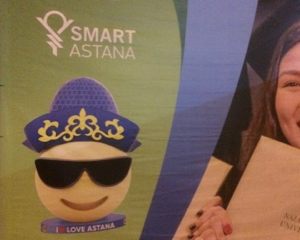 |
|
The Triumphal Arch Mangilik El (celebrates the 25th year of Kazakhstan independence). We walked under it one night on our way home from the Expo. You can go up in it, if you buy a ticket. There is an exhibition of modern Kazakhstani art in the building. |
On our first afternoon in Astana we went to the MEGA Silk Way shopping mall. We went there again to meet our friends and have lunch on our second day, and we did some shopping there. |
The MEGA Silk Way shopping mall had a great Korean restaurant (and many other restaurants, including Turkish and Russian cuisine), a Ramstor grocery market, a variety of Asian and Global purveyors of clothing, a shop selling books and toys, and Central Asian decorations. |
It seemed to me that orbs and balls and domes were a theme in the Astana architecture, and even some of the advertisements for universities or other operations used cute round objects to attract positive attention. |
|
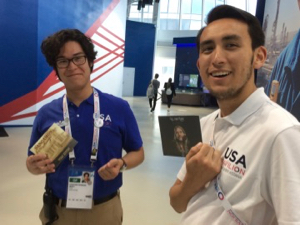 |
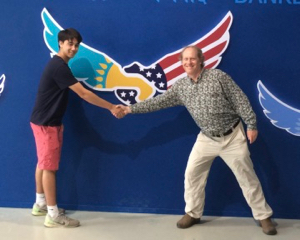 |
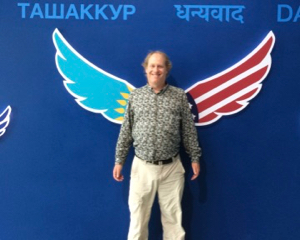 |
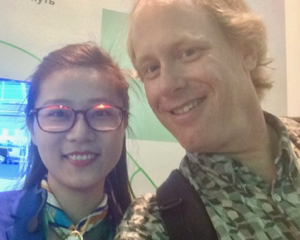 |
|
At the American pavilion I distributed CDs by Tom Irwin and suggested that he might be a good guest to have for the American cultural display. These are two of about 40 American volunteers who staff the American pavilion for the summer. They all seem to be college students who have studied Russian for at least two years. |
At the American pavilion a sign of American-Kazakh friendship offered a perfect photo opportunity for Arthur and me to shake hands, demonstrating friendship and cooperation. |
The same hand-shaking symbol could also provide a suitable angel wing prop for a photograph, as I demonstrate here. |
Most pavilions seemed to have mainly Kazakh college students (multi-lingual) as volunteer hosts, but the American and Chinese pavilion had many student volunteers from the exhibiting country. Here I met a student from Heilongjiang University in Harbin, China, a university where I had been an exchange scholar in 2012. She wasn’t from the School of Western Studies (my host institution), but at least we could share memories of Harbin and Hei Da. |
|
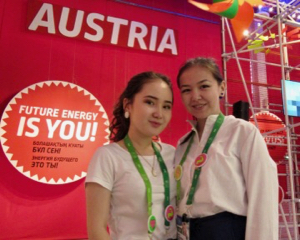 |
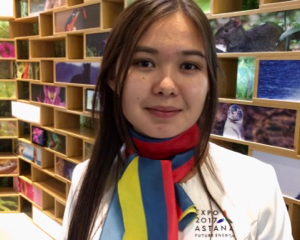 |
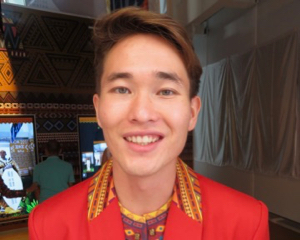 |
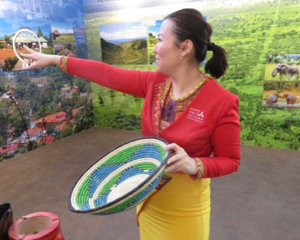 |
|
The Austrian pavilion had extremely friendly Kazakh volunteer hosts. Their English was better than their German, but so is mine, so we rested and had conversations with the volunteers. As with many pavilions, there seemed to be a ratio of about one volunteer host for every guest (but we visited late in the day, when most visitors had already left or were having dinner, I think). |
This guide we met in the Latin American pavilion is a student at Nazarbayev University (she studies political science). We had a conversation, and she told us that she has been active in organizing some support for charities in Astana, and she is also working to increase inclusion for person with physical impairments. She sounds like someone who should get a degree in social work, I thought. |
This guide at the African pavilion is one of many persons we met in Kazakhstan who had light colored eyes with Asian facial features. In Kazakhstan you can find persons with typically “East Asian” faces who have green, blue, or grey eyes, and they aren’t wearing contact lenses. My son Arthur was almost always assumed to be a Kazakh (his mother is Taiwanese), and when people realized I couldn’t speak Russian or Kazakh, they would address him, thinking that he was a local. |
There were a few Africans in the African pavilion, but most of the explanation was done by Kazakh college students volunteering for the summer. This host in the Uganda section enjoyed showing us the attractive woven reed bowl and describing what she knew about Uganda. I hope that someday she will get the opportunity to visit Uganda and see the country she has been explaining at the World Expo. |
|
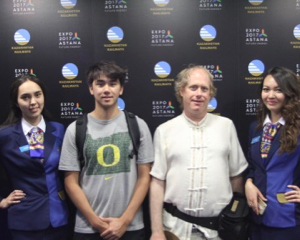 |
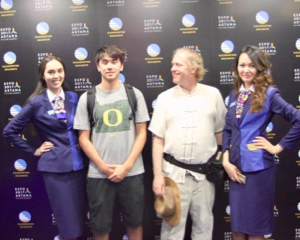 |
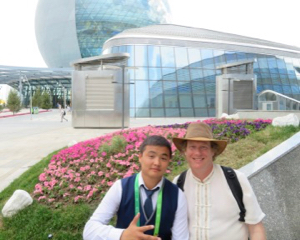 |
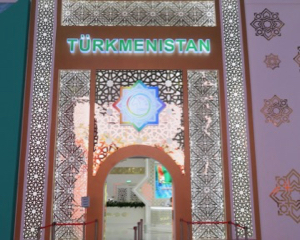 |
|
The Kazakhstan Railways exhibit featured a map showing the modern route from the Pacific Ocean to Europe, and highlighting the potential and existing role Kazakhstan could play in transportation over Asia. These two beauties also posed with us for a photograph. At over 180 cm tall, they were impressive. |
The Kazakhstan Railways exhibit had hosts that enjoyed discussing the strategic role Kazakhstan could play in transportation from the Middle East and Europe to East Asia. Rail transport can be faster than shipping, but costs must come down. I think we also enjoyed posing with these tall models who were so friendly. |
This guide saw me on each of the three days we visited the Expo, and he kept persistently trying to get me to come into the First Thematic Pavilion, which we finally did on the third day. The three best things about the Expo were: 1) friendly guides; 2) no lines; and 3) prices inside the Expo were no higher than prices outside Expo. |
Our first day at Expo we visited with our friends Michael and Olga, and their children Victor and Kathleen. Michael was due to go to Turkmenistan (his work has him travelling all over Central Asia, but he is based out of Astana), so we headed to the Turkmenistan exhibit right away, just after seeing the Russian exhibit (Olga is Russian-American). |
|
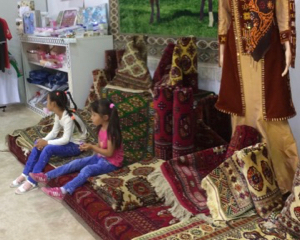 |
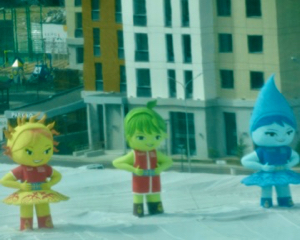 |
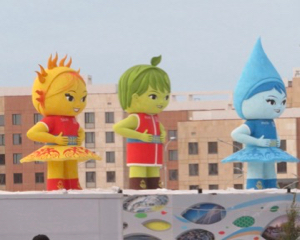 |
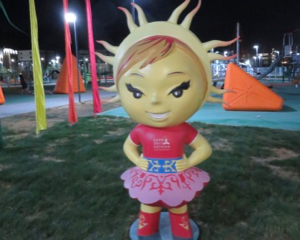 |
|
The Turkmenistan exhibit at Expo featured clothing and carpets, photographs, and handicrafts. |
Saule (energy of the Sun), Kuat (energy of the earth), and Moldir (energy of pure water and air) are the Expo mascots. |
Expo 2017 has three cute mascots, Saule, Kuat, and Moldir. |
Saule (mascot for solar energy) stands near the large playground just north of exhibits, near the North Gate. |
|
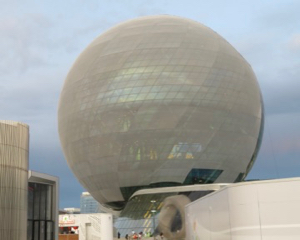 |
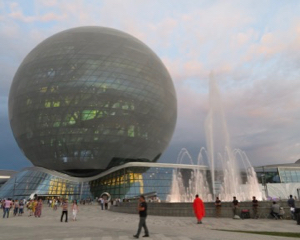 |
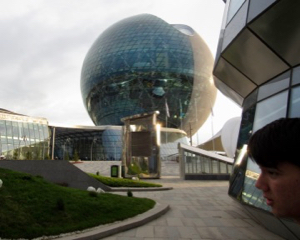 |
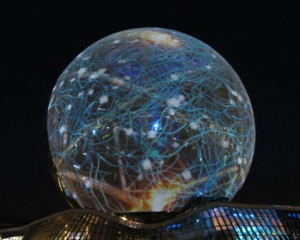 |
|
The glass orb at the center of the Expo. |
The glass orb and one of the two main fountains. |
The glass orb makes a stunning central focus for the expo. |
One night we saw an amazing laser show on the Orb, but on other nights there was merely a series of interesting LED light displays on the surface. |
|
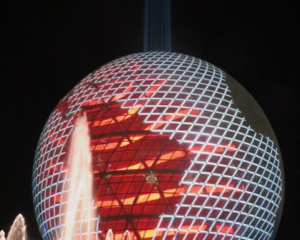 |
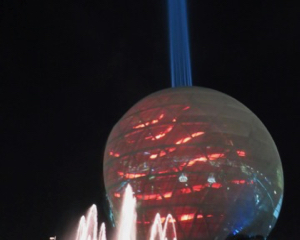 |
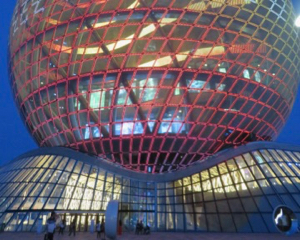 |
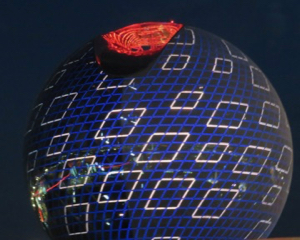 |
|
The glass orb became a globe map. |
Late at night a set of spotlights shone brightly straight up from the orb into the sky, illuminating the clouds far above the orb, or stretching out to the stars. |
Around 9:50 in the evening the light was just right to admire the Orb. |
The top of the Orb has fans to pull in air and help circulate air within the large building. In addition to the base floor, there are seven floors within the orb itself. |
|
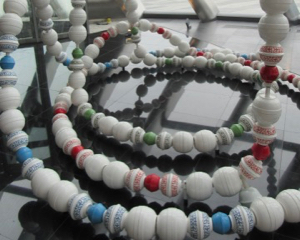 |
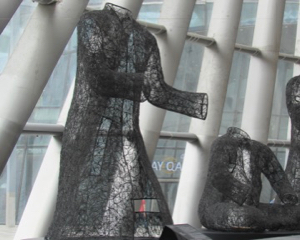 |
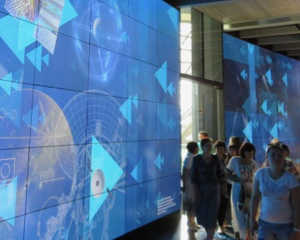 |
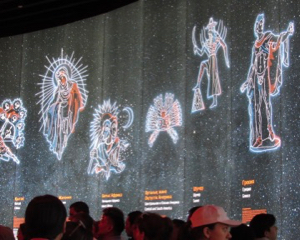 |
|
The base level of the orb (not actually in the orb, just the ground floor under the orb) was used to exhibit modern Kazakstani art and culture. |
Kazakhstan is known for its wonderful modern art, and many of the works on display in the ground floor below the orb were made by young artists (under 31 years old). |
Inside the Orb each of the seven floors were devoted to forms of energy, including space energy, solar, wind, bio-energy, water, and so forth. |
On the floor devoted to the energy of the sun there was a display explaining various sun gods and allowing people to experience a multimedia show inside a miniature sun globe. |
|
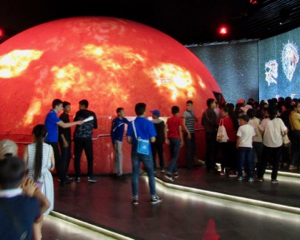 |
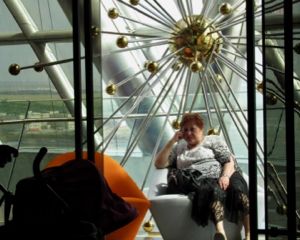 |
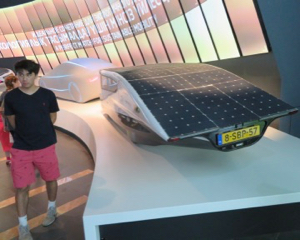 |
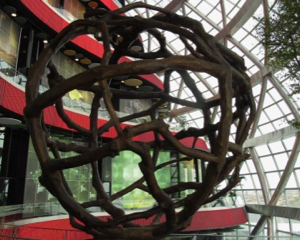 |
|
This is the sun globe on the fifth (of seven) floors inside the orb. The show inside it was worth the short wait; the longest wait we had for anything at the Expo (about 20 minutes). |
Visiting an Expo can be exhausting. This woman is taking a break on a comfortable chair in front of a sculpture on one of the higher levels of the Orb. |
On the sun power level there were some solar-powered cars. |
One of the large sculptures inside the orb. |
|
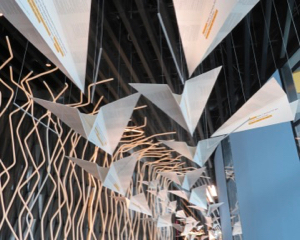 |
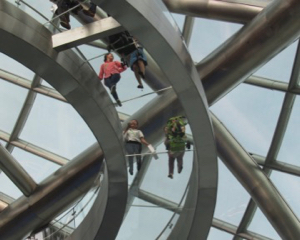 |
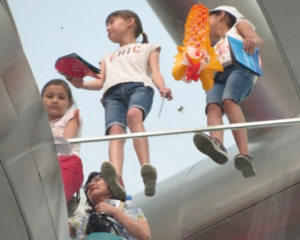 |
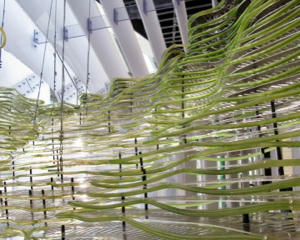 |
|
The paper airplanes have on them the text of the Paris Accords for reducing greenhouse gasses and moderating global warming. I suppose in some cultures the paper airplanes suggest flght and success, but to me, I just thought of someone taking the official treaty, which is so serious and important, and making paper airplanes out of it to show how carelessly and lightly they were valuing the Paris Accords. |
Up on the top floor (the eighth floor, the seventh floor inside the Orb) there was a glass walkway so that people could walk out over the atrium and have the thrill of looking straight down. Down on the third level we could look up and see the people walking above us. Some of them seemed nervous walking out on a glass walkway about thirty or forty meters above us. |
Walking on the glass walkway at the top of the orb some children seem comfortable, but one seems a bit nervous. |
In the bio-energy section of the Orb was a display about using algae to create energy, as is being done in a small way in a demonstration project in Germany. A small demonstrating display was presented to visitors, and I thought it was interesting as a living art installation, as well as a functioning energy-generating system. |
|
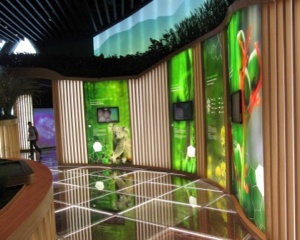 |
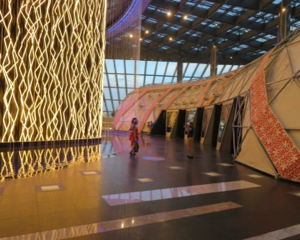 |
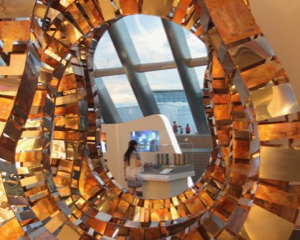 |
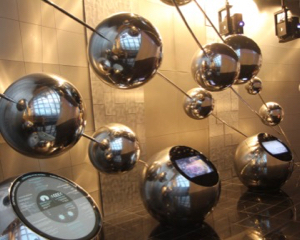 |
|
Much of the Expo involved reading information presented in attractive physical spaces with photographs of breathtaking beauty. |
The Kazakhstan exhibit on the ground floor was much smaller than any national exhibit of a host country I have ever seen at any Expo before this one. |
Some of the charm of the Kazakhstan exhibit came from the mix of modern art (much of it quite good) with displays celebrating traditional Kazakh culture. |
The people who created the exhibits mixed aesthetic principles of design and artistic sensibilities with pedagogical functions, sometimes getting a nice blend of art and scientific/technical education. |
|
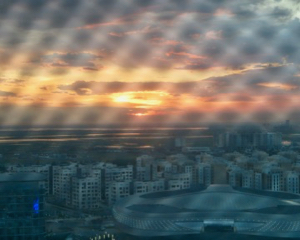 |
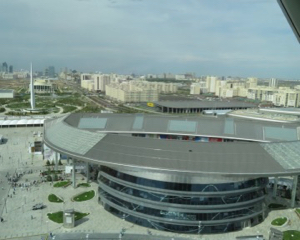 |
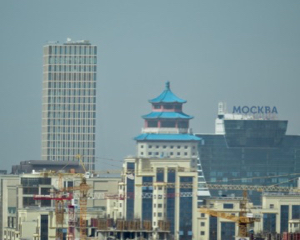 |
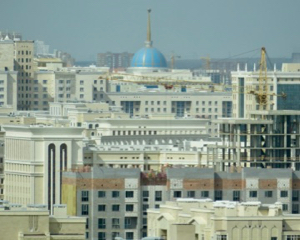 |
|
The sunset (at around 9:30 on June 17th) as seen from the top floor of the Orb. |
Looking out of the Orb toward the north. |
Gazing out from the Orb to the north toward the Beijing Palace Soluxe Hotel Astana. |
The dome and spire of the Presidential Palace in Astana stand out from the many new buildings and construction cranes. |
|
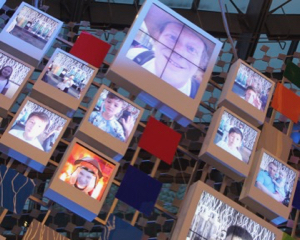 |
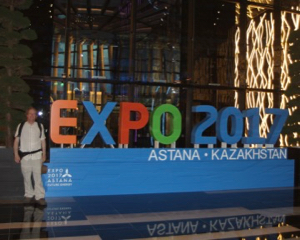 |
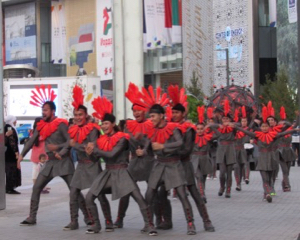 |
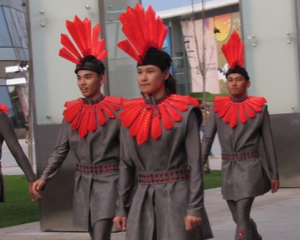 |
|
That is my face on this display of people who are ready to help make the transition to future sources of energy (renewable energy). |
Here I stand by the Expo 2017 sign in the ground floor below the Orb. |
The evening parade (held each night around 9:00 or 9:15) at Expo. |
This group of marchers in the parade may have been representing the power of geothermal energy, or perhaps the more elemental power of fire. |
|
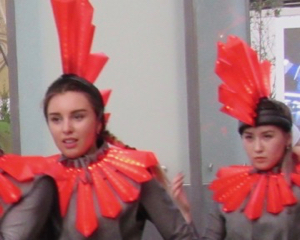 |
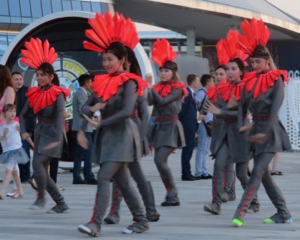 |
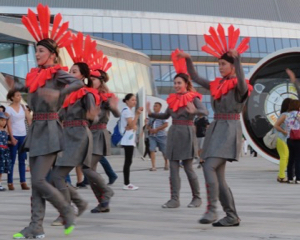 |
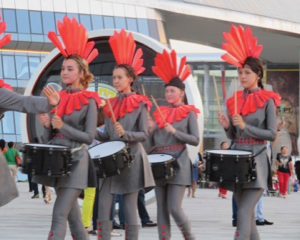 |
|
The Kazakhstani people remain diverse, with many non-Kazakh people living as minorities and taking part in cultural events like this parade. Kazakhstani people are citizens of Kazakhstan of any ethnicity. |
This group had fun costumes. There were also some people with silver costumes who were roller-blading around, but they moved so fast I could not get good shots of them in the dim twilight. |
The music playing as these people walked by in their fanciful costumes was sometimes oppressive and heavy, as if this group wielded some awesome and dark power that threatened us all. |
The drums in the parade were great. The parade could have used more drums and more people playing instruments. |
|
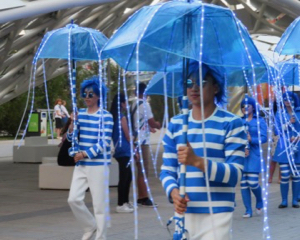 |
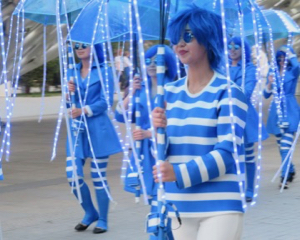 |
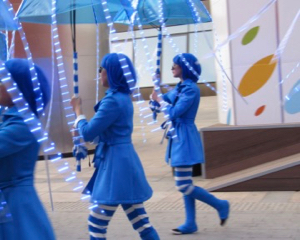 |
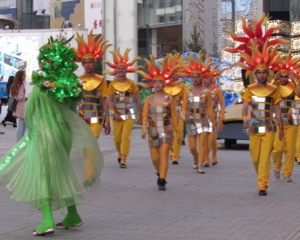 |
|
The evening parade at Expo. I suspect that these blue costumes have something to do with hydro-electric and geothermal energy. |
I especially liked the blue glasses worn by the people in this section of the parade. |
Why do people only wear such interesting clothing when marching in parades? I want to see crowds of people dressed in styles this interesting of all different colors. |
The people with yellow and red costumes probably represent the energy of the sun. |
|
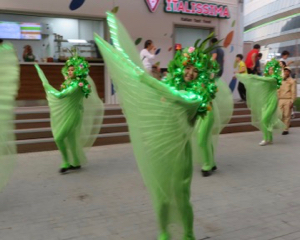 |
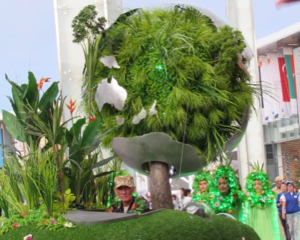 |
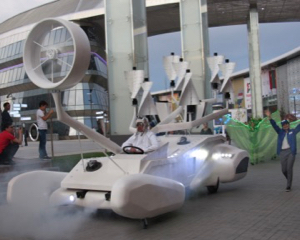 |
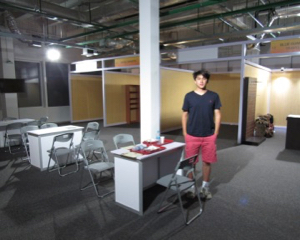 |
|
There were people in the parade with green costumes like these scattered from the start through the end of the procession. I believe the green costumes represent the energy of the earth: bio-energy and so forth. |
This float in the evening parade was funny; the man driving it seemed out-of-place, since everyone else was so young and enthusiastic, and other people were wearing exotic costumes. This guy looked completely relaxed and unimpressed, and apparently he was about 50 years older than everyone else in the parade. |
The parade included some exotic cars or floats. It must have been fun to design and build these contraptions. |
We attended the Expo in its first week of being open, and about 80% to 90% of the things were open. One night, in our search for vegetarian food, we found an Indian restaurant up above the Indian exhibit. We were the only customers. The proprietor was a devotee of the cricket “religion” (sport), and showed evidence that he played with other cricket adepts even in the winter on frozen lakes in Astana when the temperature was 15 below freezing. We later learned that our friend Victor also played winter cricket on the ice with the local cricket club. |
|
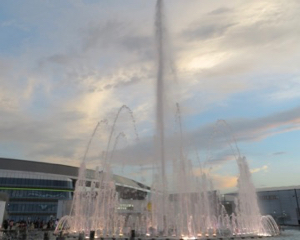 |
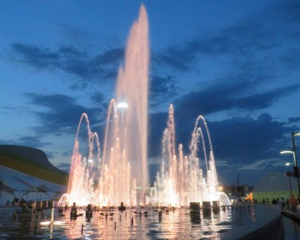 |
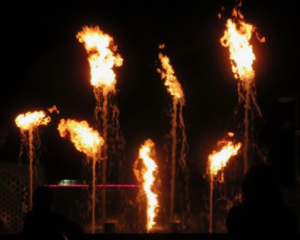 |
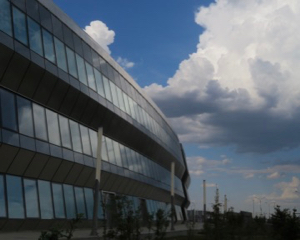 |
|
This is one of the two twin fountains north of the Great Orb. |
Around 10:00 at night, after the parade, people gathered around the fountain to watch the Orb change colors. |
Sometimes there were jets of fire or flaming water in the fountains. I guess flaming water in Kazakhstan has not the connotations I associate with it (the Cuyahoga river fire). |
This expo has constructed permanent buildings, rather than temporary ones, and after the expo closes in September, these buildings will become offices in a financial center or technical research park. |
|
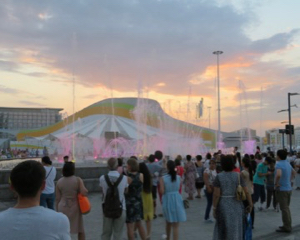 |
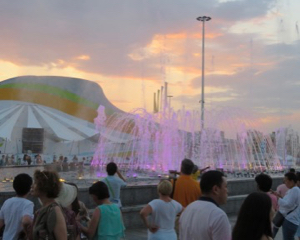 |
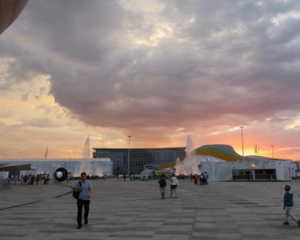 |
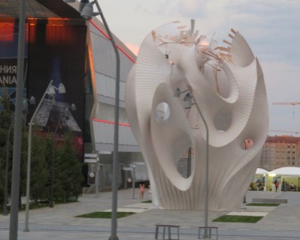 |
|
Sunset at Expo 2017. |
Fountains lit with glowing colors and the sky lit by a warm sunset. |
The Kazakh architects seem to like using wide open spaces and large distances in the Astana city plan and the Expo site design. |
The various sculptures around the Expo grounds (such as this one shown above) enhanced the feeling that something creative and unusual was happening. |
|
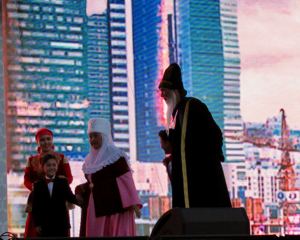 |
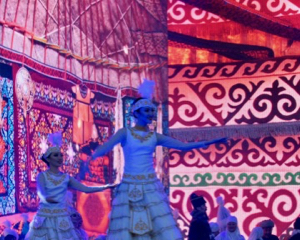 |
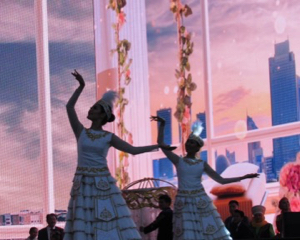 |
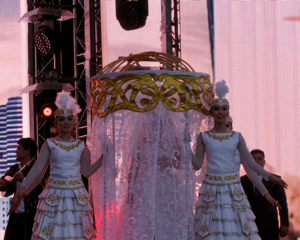 |
|
We were extremely lucky to catch a long historical dance and song show featuring remarkable costumes and narration with English translations projected on walls. |
Program narration: “Today’s boys and girls open the pages of their parents’ writings, books and photo albums with awe. In their childish imagination, the old images move again. Once more, they breathe with life, reminding the children of the wisdom and experiences of past generations.” |
Program narration: “Folk and family histories are passed on from mouth to mouth. Scrolls, books, drawings and photographic images from the past are handed down. When we encounter them today, we are magically transported into our shared past.” |
Program narration: “Time passed. The bright colours of the celebration gave way to the routine of family life. This, though, was soon also brightened up, by a real miracle. The miracle of the birth of a child. The young couple have had a son. Strong and healthy—a future warrior” |
|
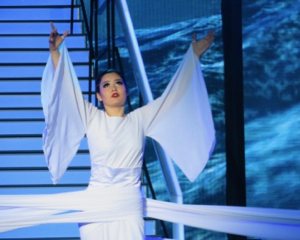 |
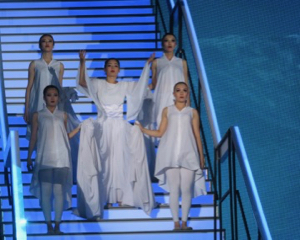 |
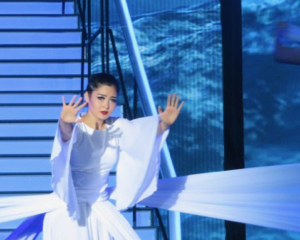 |
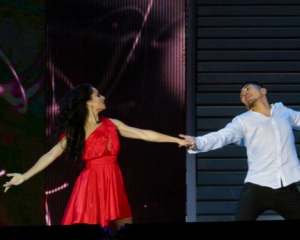 |
|
Program narration: “How did everything begin? How was this most beautiful of worlds created? Once, long, long ago, there was nothing. Chaos and eternal night reigned everywhere. Cold and emptiness. Endless darkness. And then Tengri created the upper world. The eternal blue sky blazed with colour and shone with stars.” |
Program narration: “Then, Tengri ordered this empty and hazy world to be filled with the spirit. Umai, the foremother, came down to the middle world in the form of a beautiful bird. She tried to build a nest and to create life, but her egg fell into the ocean and sank into the deep. Next, Umai tried to weave a nest from her own feathers right on the waves.” |
Program narration: “But the waves broke it up and carried the feathers away into the black depths of the ocean. Tengri then commanded Umai to make land. Umai fetched some clay from the bottom of the ocean. With it, she created land.” |
Program narration: “And so, way up high in the Karatau Mountains, life-giving rain found its way into a cave. The raindrops carved human figures into the rock. The divine water filled them, and the magical rain stopped. At that moment, a bright light lit up the horizon. The blinding sun blazed up in the sky.” |
|
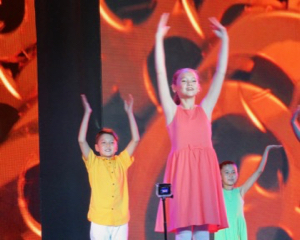 |
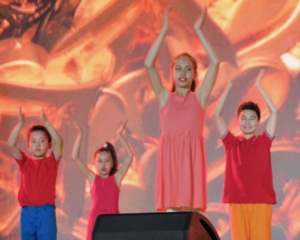 |
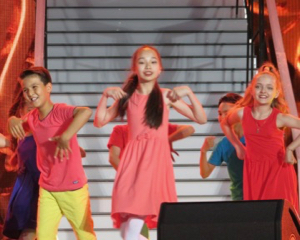 |
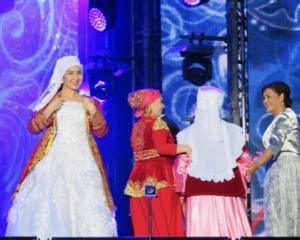 |
|
Program narration: “Its warm and tender rays entered the cave. Instantly they heated the rock and breathed life into the human figures. Next, the heart of Tengri himself descended into each of the figures via the sun’s rays.” |
Program narration: “Al-Atam and Kun-Sulu were the only two people on Earth, and they were lonely. But soon they understood their purpose, conceived by the great Tengri himself. Umai, the foremother, breathed a wonderful new feeling into them: love.” |
Program narration: “This happened in the far distant past, many centuries ago. The first people then saw the course of time begin. The moon appeared in the sky along with the sun. Ever since, night has followed day, and the cool of the evening has followed the midday heat, and the people learned how to measure time from the movement of the sun and the moon.” |
Program narration: “The stars taught them how to navigate the middle sea, cross mountains and rivers, great steppes and deserts. With time, people broadened their knowledge and learned various crafts.” |
|
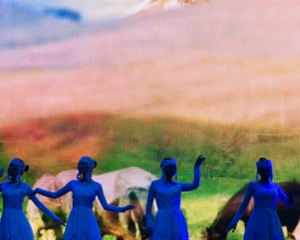 |
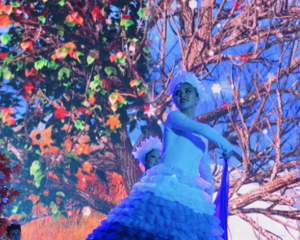 |
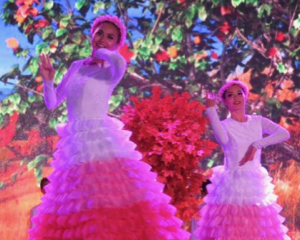 |
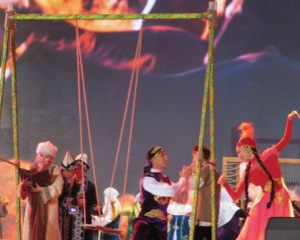 |
|
Program narration: “Everything in the world conceived by Tengri is constantly tending towards order and perfection. Once set in motion by Him, time has never stopped. Inexorably, it has rolled forward, turning the present into the past. The first generations of people gave way to younger ones.” |
Program narration: “This continued for a very long time. Even so, the people had yet to learn how to deal with time, and to derive order and meaning from it. The young did not repect old age. The elderly did not think about passing on their experience to their descendants.” |
Program narration: “Tengri then decided to tame the torrent of time. He divided its flow into 12-year periods, and the year into twelve months and four seasons: spring, summer, autumn and winter. Time was given order, and people began to measure their lives using its cycles.” |
Program narration: “Ever since, everyone has known that the spring gives birth to new life. Next comes the sun-drenched summer of youth, followed by the mature autumn, before winter reigns again.” |
|
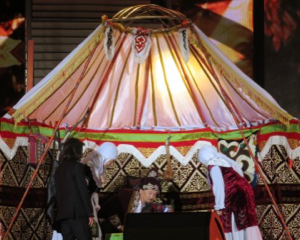 |
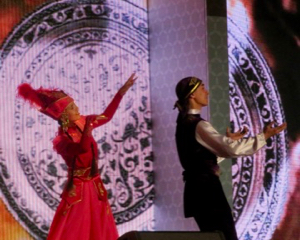 |
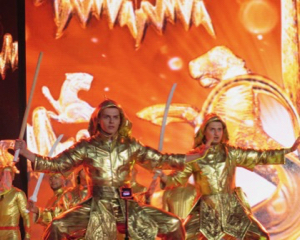 |
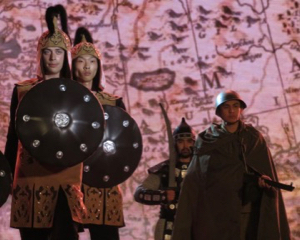 |
|
Program narration: “Night continues to follow day. The years passed into centuries. As they did, the human race expanded, spreading around the world and populating every corner. But then one family, who already had nine children, had a tenth: a boy with a lock of golden hair on the top of his head.” |
Program narration: “He grew not by the day, but by the hour. A bold and artful child. In those difficult years, the great steppe was often threatened by enemies. The warriors always put them to flight. But courage and strength alone were not enough to protect their native land.” |
Program narration: “Tengri gave the boy with the golden lock the ability to work with metals and to make from them steel swords and strong armour. They were outstanding in their beauty, because everything conceived by Tengri in this world strives towards perfect beauty.” |
Program narration: “Everything in the world conceived by the Almighty is always aspiring towards order and perfection. Order in people’s lives is provided by the eternal El, the just state. In that difficult period, whole tribes moved far away into unknown regions, countries fell apart, and violent hostility flared up between peoples.” |
|
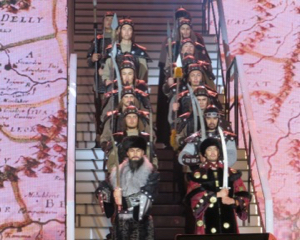 |
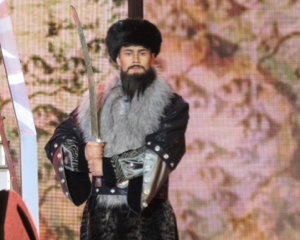 |
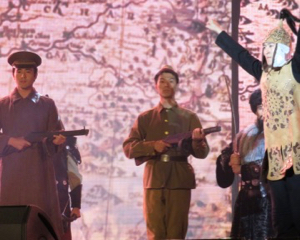 |
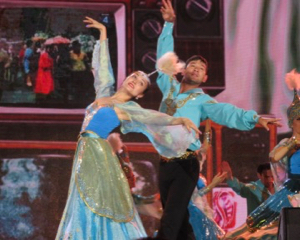 |
|
Program narration: “Then, as their ancestors had willed, the people resolved to unite their tribes and families into a new Khanate and to revive the fragmented heart of the Great Steppe under its protection. Janybek Khan and Kerey Khan declared the foundation of the Kazakh Khanate. It was to be powerful and free. This happened long ago, in the year 1465.” |
Program narration: “The heart of the Great Steppe came together in unity. The people combined their dreams and aspirations. In peace, development, learning, enjoyment and prosperity. More and more people joined the ‘eternal union, to do good’ as the Great Kultigin willed us.” |
Program narration: “Thanks to their valour, people no longer lived in fear, and could be confident that their homeland would be a land of freedom and justice. Today, their names are remembered and revered. Their exploits are sung of and exalted by their descendants. Their deeds live on and are continued by people today.” |
Program narration: “History turns the pages of the book of centures and events, which is like an ancient manuscript.
Now the steppe saw a new chapter: the age of communism — the Soviet Era.
This brought new influences and new developments.” |
|
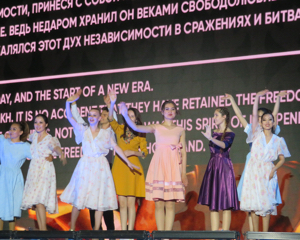 |
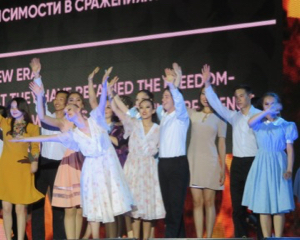 |
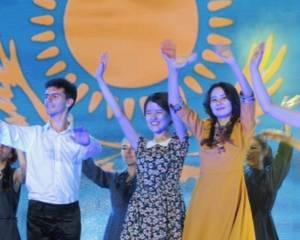 |
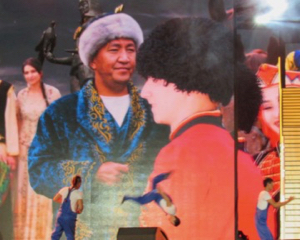 |
|
Program narration: “Day by day, the Kazakh Repbulic transformed and flourished. Towns and villages grew and developed. Universities, theatres and new sporting venues were constructed. Gradually, step by step, Kazakhstan built up its industry.” |
Program narration: “And then came indpeendence day, and the start of a new era.
Its spirit lives on in every Kazakh. It is no accident that they have retained the freedom-loving nomadic spirit over the centuries. Not for nothing was this spirit of independence forged in the fighting and battles for the freedom of our homeland.” |
Program narration: “The sun has warmed this land for many centuries. For hundreds of years, blizzards and the biting wind have reigned here. Thousands of times, the life-giving rain has fallen.” |
Program narration: “People from hundreds of different backgrounds have given it the sweat of their labour. So that one day a wondrous city might arise here. Like a dream come true, an embodiment of the talent and expertise of the people of the Great Steppe. A reflection of its great history and faith in a bright future.” |
|
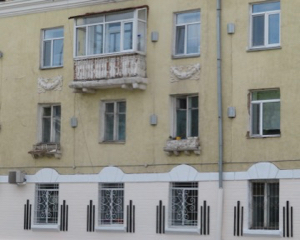 |
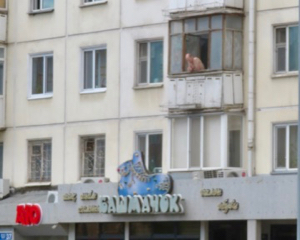 |
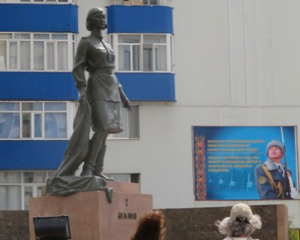 |
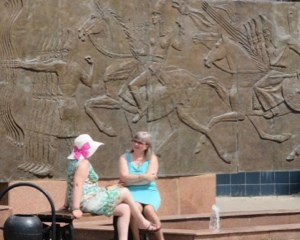 |
|
One day I joined an expatriate walking group to explore the neighborhood of older buildings near the old railroad station, walking down Pobedy / Zhengis Avenue from театр Жастар to Особа restaurant on Kenesary Street. The photograph above shows the decorative style of Soviet architecture. |
Along Pobedy / Zhengis Avenue this shirtless man was looking out of his balcony window over the street. His building is a typical five-story (no elevators) apartment building with retail stores and commercial offices on the first floor. |
A statue to Alia (Alia Moldagulova, Әлия Нұрмұхамедқызы Молдағұлова). She was a young Kazakh (18 years old when she died) sniper who took command of the 54th shooting brigade when the commanding officer was lost, and led her comrades in an attack on Nazis. |
I thought there was an amusing contrast between the panel behind these two women (depicting military exploits and valor) and their activity, quietly resting and enjoying a casual chat in the sunshine. The heroic monuments to warrior heroics provides a venue for peaceful and quiet moments of friendly visiting. |
|
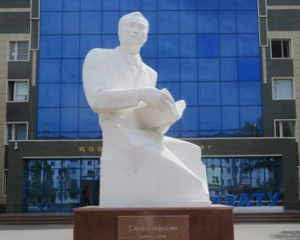 |
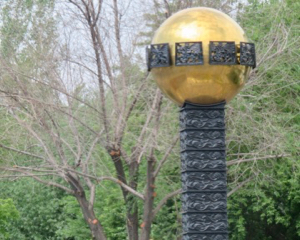 |
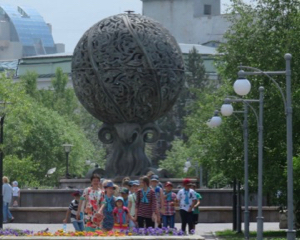 |
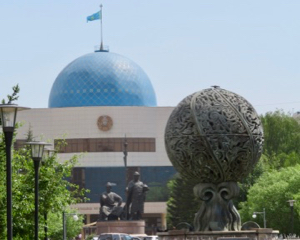 |
|
A statue of Saken Seifullin (1894-1938) in front of the Agrotechnical University (there is another statue from 1994 of him sitting on a chair elsewhere in Astana). |
I do not know what this is. It is a thing. It was along Pobedy / Zhengis Avenue. |
In New Square you can see this stylized statue of the Baiterek (the tree of life). |
Looking across New Square and the Tree of Life fountain you can see the blue dome of the Museum of the First President of Kazakhstan. We did not go in there. |
|
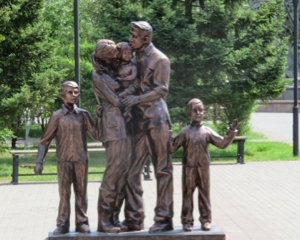 |
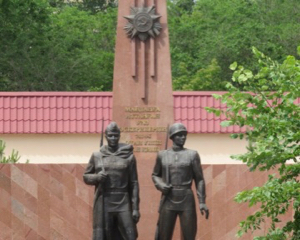 |
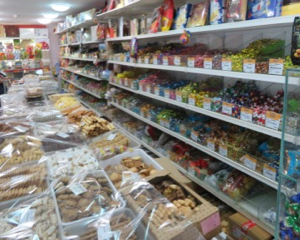 |
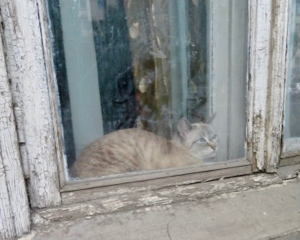 |
|
This charming statue of a Kazakhstani family is a new addition (added only weeks or days before our arrival; the people in our walking group had not seen it before) to the art gracing New Square in Astana. |
Another war memorial. This monument reminds people in Astana about the sacrifices of the Great War Against Fascism in the 1940s. The monument dates to the Soviet Era. |
The best candy shop in Astana, also offering many good cookies, stands along Pobedy / Zhengis Avenue. |
Along Pobedy / Zhengis Avenue, on the far north side of Astana, some of the buildings date back to the 1950s, and many date to the 1970s and 1980s. The windows in this building look original, although the cat is not as old. |
|
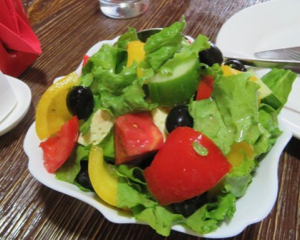 |
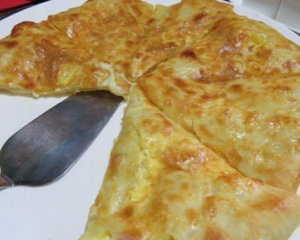 |
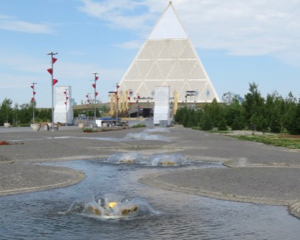 |
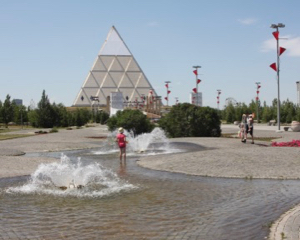 |
|
The walking group had lunch in a Georgian restaurant (Особа) and the food was outstanding. |
Georgian Kachapuri is even better than a cheese pizza. All the dishes at Особа were excellent and generous in portion size. |
The Palace of Peace and Reconciliation in the morning when no one is around. |
The Palace of Peace and Reconciliation on a hot afternoon when children are playing in the water fountains. |
|
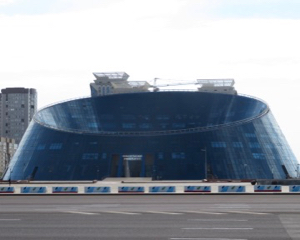 |
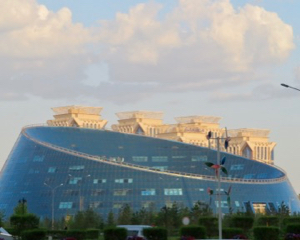 |
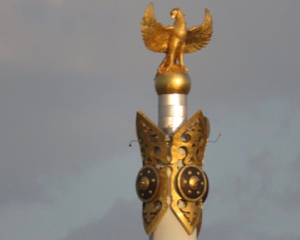 |
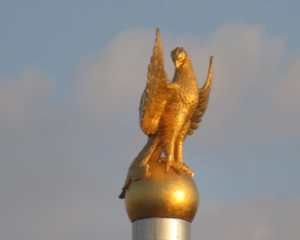 |
|
This is the Shabyt Palace of Creativity “Шабыт” шығармашылық сарайы just east of the Peace and Reconciliation Palace. Concerts are held here. The architecture of Astana goes on like this. |
The Shabyt Palace of Creativity is shaped like the print of a horse hoof in the soil of the steppe. Victor suggested it would be fun if the center could be filled with water and converted into an outdoor swimming facility. |
The top of the Monument Kazakh Eli. |
The Samruk bird perched atop the Monument Kazakh Eli on Independence Square. |
|
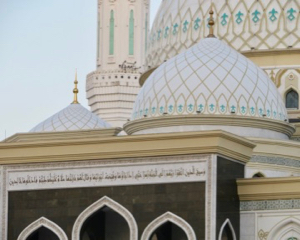 |
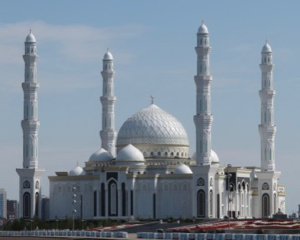 |
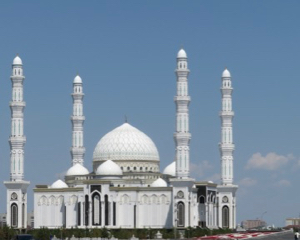 |
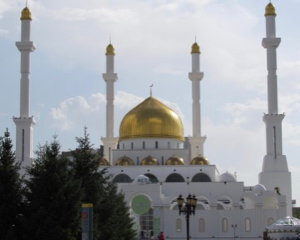 |
|
The Hazrat Sultan Mosque in Astana. |
The Hazrat Sultan Mosque in Astana, the largest mosque in Kazakhstan. |
The Hazrat Sultan Mosque in Astana, opened in 2012, popular for weddings. |
The Nur-Astana Mosque in Astana (2005), is associated with Absattar Derbisali. |
|
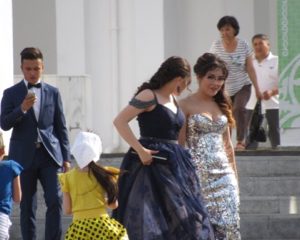 |
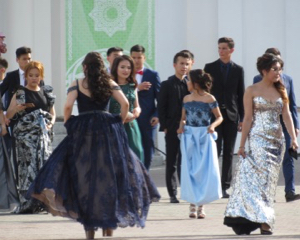 |
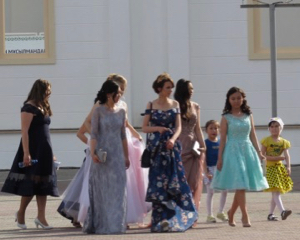 |
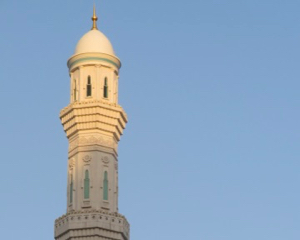 |
|
A group coming out from the Nur-Astana Mosque. |
A group coming out from the Nur-Astana Mosque. |
A group coming out from the Nur-Astana Mosque. |
Minaret on the Hazrat Sultan Mosque. |
|
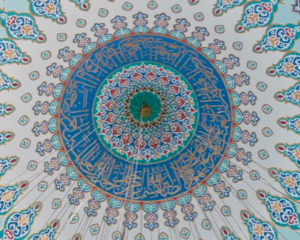 |
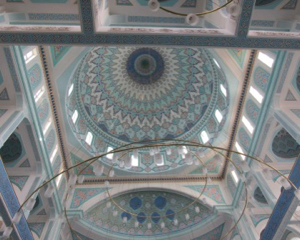 |
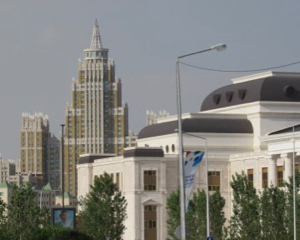 |
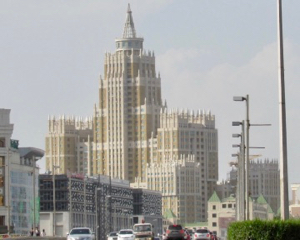 |
|
Interior dome in the main prayer hall of Nur-Astana Mosque. |
Interior ceilng of Nur-Astana Mosque. |
The Triumph of Astana is a postmodern (2006) building in the style of the Soviet Sugarcake style set by the Seven Sisters in Moscow. Here you can see it past the theater on the right. |
I do not know why Astana has a 142 meter high skyscraper with 39 floors built in the style of the Soviet sugarcake buildings of the 1940s-1950s, but it makes me smile to see this Triumph of Astana building. |
|
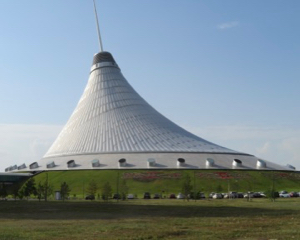 |
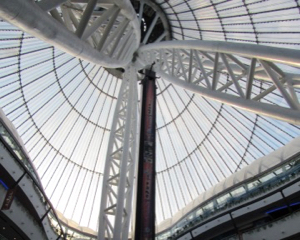 |
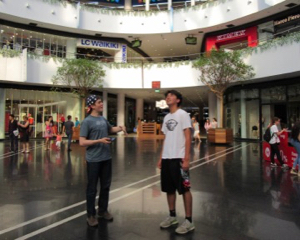 |
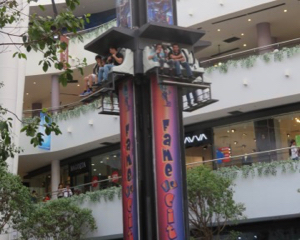 |
|
The Khan Shatyr Entertainment Center, designed by Norman Foster, who also did the Palace of Peace and Reconciliation. |
Looking up insde the Khan Shatyr Center. |
The Khan Shatyr is mostly a shopping mall, but there are two floors of amusements, and the top floor has a swimming pool with sand. |
Victor very generously treated me and Arthur to a ride in this thrilling ride inside the Khan Shatyr Center. I could not stop laughing during the ride; it was incredible. |
|
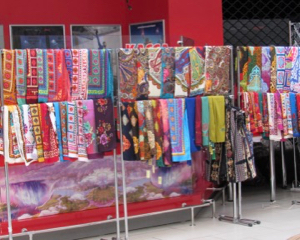 |
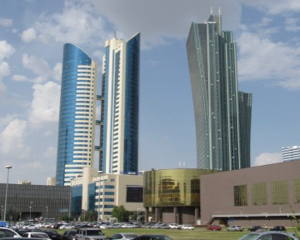 |
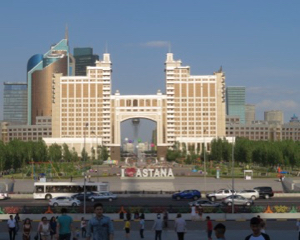 |
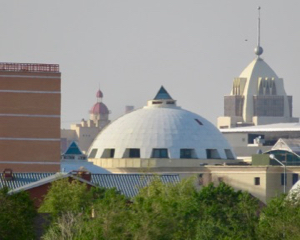 |
|
Scarves and handicrafts were availabe in the Khan Shatyr Center. |
Typical downtown Astana. |
Looking east from the Khan Shatyr Center toward the KazMunaiGas Building (with the arch) and the Bayterek Tower. |
Looking northeast from the Khan Shatyr Center over the roofs and domes of Astana. |
|
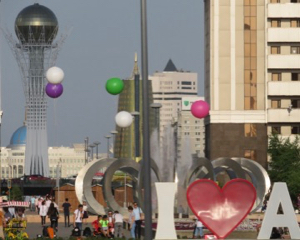 |
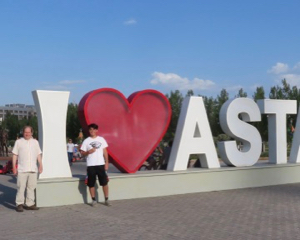 |
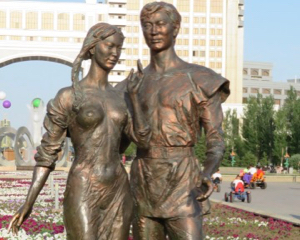 |
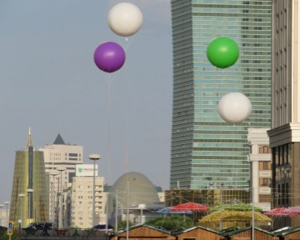 |
|
Looking down the axis across Lovers Park to the Bayterek Tower and the Presidential Palace. |
Eric and Arthur pose at the “I Love Astana” sign in Lovers Park. |
The Kazakh couple in Lovers Park caused controversy as the girl’s diaphanous dress disturbed some local residents. |
Central Astana along Nurzhol Boulevard. |
|
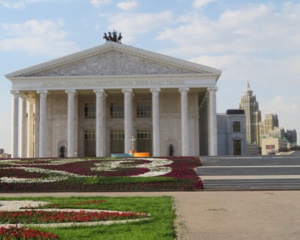 |
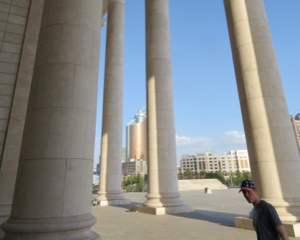 |
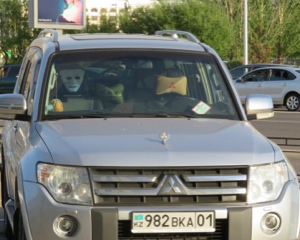 |
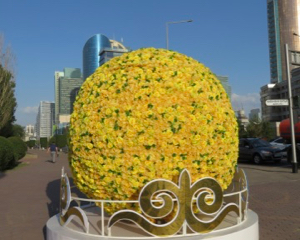 |
|
The new Astana Opera Building. |
Colossal columns on the Astana Opera Building. |
A mysterious mask in a car parked at the opera. |
There are many decorative elements and statues at street corners in Astana. |
|
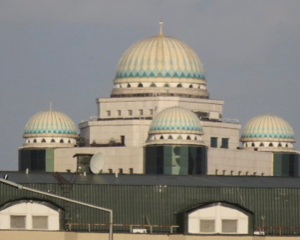 |
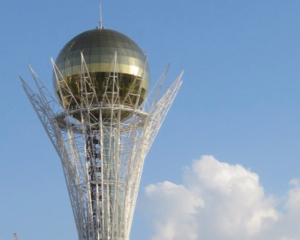 |
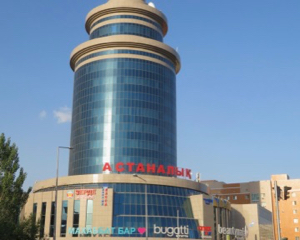 |
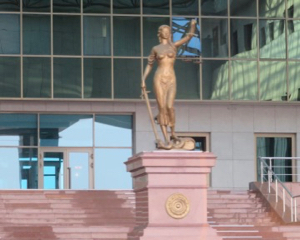 |
|
Domes on the Senate of the Parliament of the Republic of Kazakhstan. |
The golden ball of Bayterek Tower. |
The Astanalyk office building and shopping center. |
The Supreme Court of the Republic of Kazakhstan. |
|
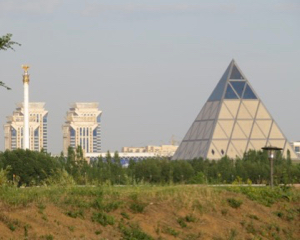 |
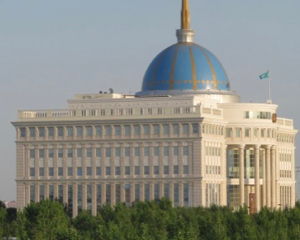 |
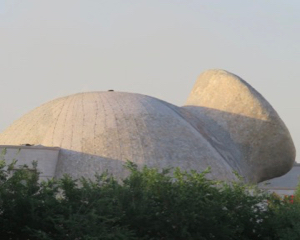 |
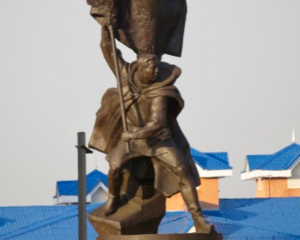 |
|
A view of the Palace of Peace and Reconciliation seen from the Sarayshyq Street Bridge over the Ishim River. |
The Presidential Palace seen from the bridge over the Ishim River. |
The Astana Music Hall. |
A monument to Rakhimzhanov Koshkarbayev, the Kazakh soldier in the Red Army who, along with Grigoriem Bulatovym, first waived the Soviet flag over the Reichstag in Berlin (in May of 1945). Rakhimzhanov was a local kid from the Akmola area (Akmola was the old name for Astana). |
|
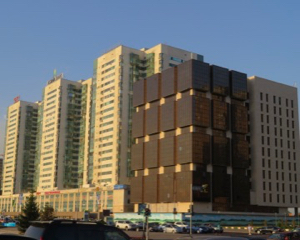 |
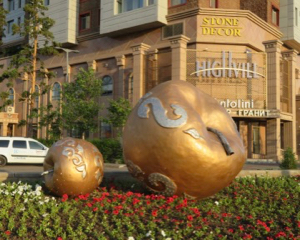 |
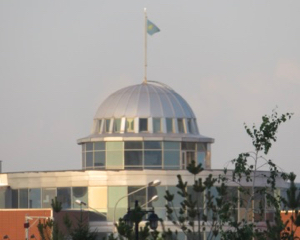 |
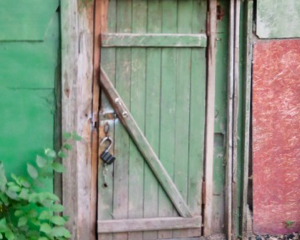 |
|
The Highville Apartment Development, built by a Korean company, and a favorite residence for the Astana expatriate community. |
Approaching the Highville apartment complex. |
A dome on a building off in the distance of the northeastern section of Astana, seen from Highville. |
A door to a garage or shed in the Zarechnoe (Заречное) area of Astana (we stayed in this neighborhood). |
|
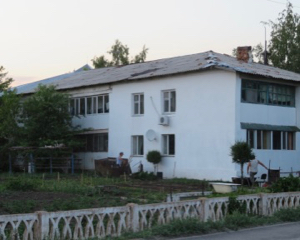 |
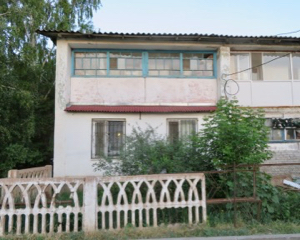 |
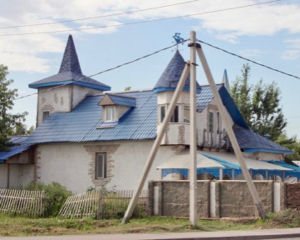 |
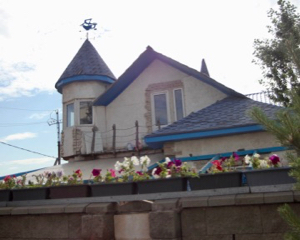 |
|
Typical old residential building in the Zarechnoe neighborhood. |
Some of the buildings in the Zarechnoe neighborhood date back to the Virgin Lands campaign (early 1950s) when Russians, Ukrainians, and others were relocated to Akmola (now Astana) to help grow wheat on the steppes. |
The old building at the corner of Yengbekshiler Street and Kerey & Zhanibek Khans Street. |
The view of the quaint old house on Yengbekshiler Street in the northwest corner of the Zarechnoe neighborhood of Astana. |
|
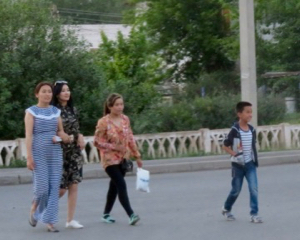 |
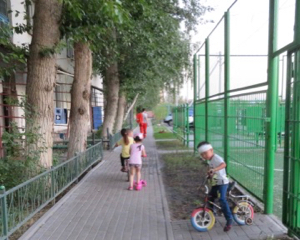 |
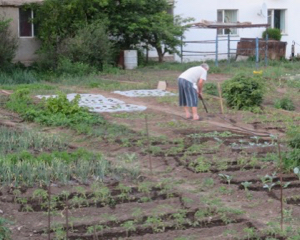 |
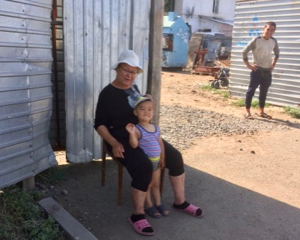 |
|
The Zarechnoe neighborhood on a summer evening has lots of people out taking strolls, and the smell of grilling meat is everywhere. This is an older Russian neighborhood dating back to the 1950s. |
Children playing in the Zarechnoe neighborhood. Most residents of Astana are from somewhere else, and have no roots in this new city, but a few families have been here for 60+ years, as in this neighborhood. |
The Zarechnoe neighborhood has many single detached homes with gardens, unlike modern Astana, which is almost all made up of modern efficient apartment buildings. |
Walking along Yengbekshiler Street we waved hello to this woman and little boy, and they smiled and waved back. |
|
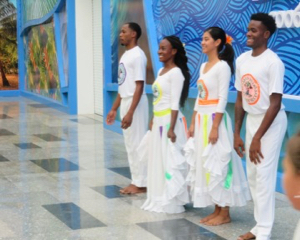 |
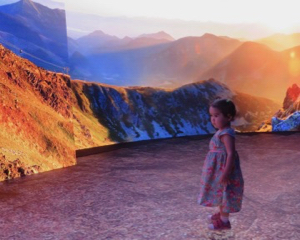 |
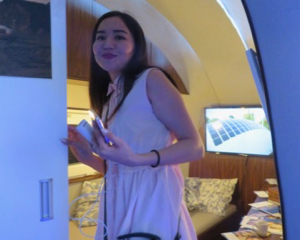 |
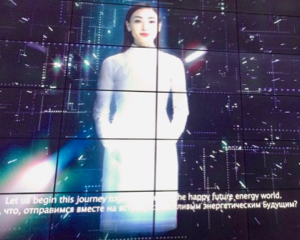 |
|
Dancers from Belize perform at the Expo. |
A little girl enjoys the Slovak exhibit at the Expo. |
The Slovak exhibit included a cute little solar/wind powered recreational trailer, and this Kazakh woman has been enjoying exploring the model on display. |
In the Second Thematic Pavilion guests learned about the necessary transition to new energy sources for the future. |
|
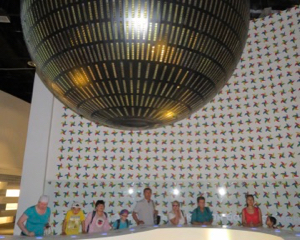 |
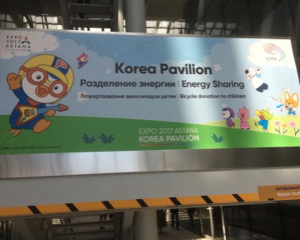 |
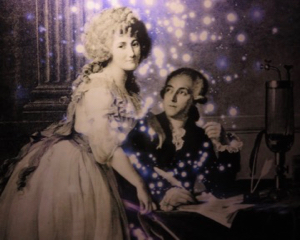 |
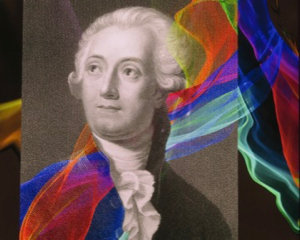 |
|
Artistic exhibit including pinwheels made by Kazakhstani children in the Second Thematic Pavilion. |
The Korean Pavilion offered guests cute animation and a story about renewable energy and solar-powered flight. |
The French pavilion featured many things, including translucent concrete and information about Marie-Anne Paulze Lavoisier and Antoine Lavoisier. |
The color adds some dynamic energy to this old portrait of Antoine Lavoisier in the French pavilion. |
|
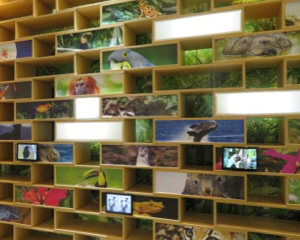 |
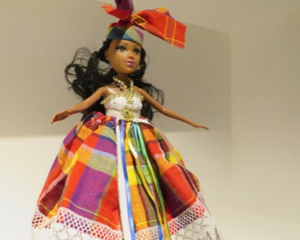 |
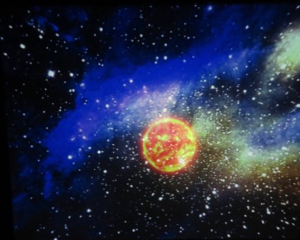 |
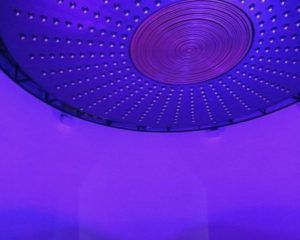 |
|
There was a Latin American pavilion, and I had the impression that people in Kazakhstan confuse all the various Latin American countries the same way we in the Western Hemisphere group all the various Central Asian countries together. |
The displays in the Latin American pavilion, the Caribbean pavilion, and the African Pavilion were generally sparse. This doll represents the national costume of Dominica, the tiny island nation in the Leeward Islands of the Caribbean. |
Artists and animators contributed many dynamic visions about energy and the future in various pavilions at the Expo. |
In one of the thematic pavilions the coil and balls in the ceiling of this room descended and moved around in a sort of musical dance performance about energy of the future. It was more aethetic and impressionistic than informative, but that was fine with me. |
|
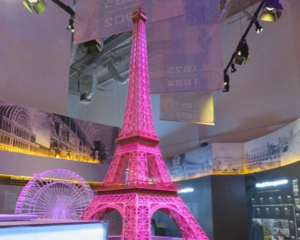 |
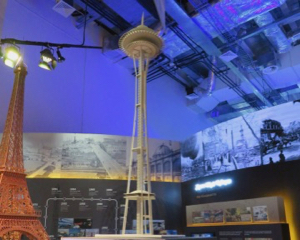 |
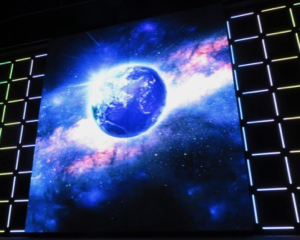 |
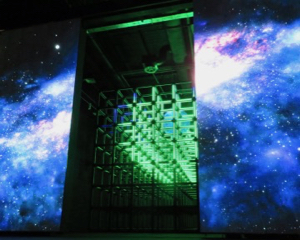 |
|
The museum of international exhibitions had models of some of the architectural innovations associated with World Expos of the past, including this Eiffel Tower. |
The Seattle Space Needle is another architectural tower associated with the World Expo. |
In a thematic pavilion we learned about the Smart Grid. The presentation was memorable for the lights, shapes, and music we experienced. |
Representing the smart grid in which customers and energy providers communicate back and forth about use, this display used flashing lights and techno trance music to create a chill atmosphere. |
|
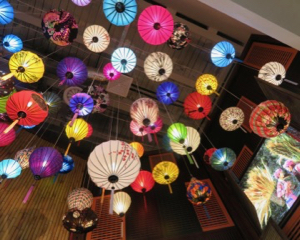 |
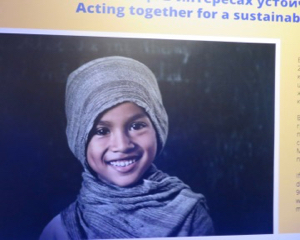 |
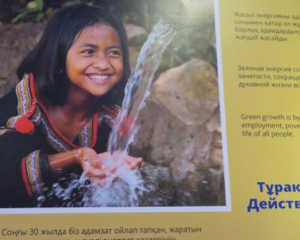 |
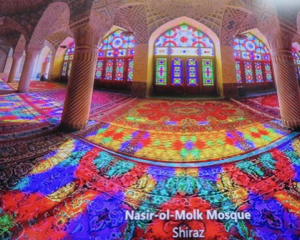 |
|
The ceiling in the entrance to the Vietnam exhibit was notable for its colorful inverted umbrellas. |
Most pavilions had photographs of smiling children and things representing energy or water or conservation. The exhortation to “act together for a sustainable future” prompted me to wonder about how people can “act together” in societies lacking solid civil society institutions or any tradition of free citizen input into the governing process. What if I want a sustainable future, but I live in a dicatorship where the government wants to rely on an unsustainable energy system or promote energy projects that I oppose? |
Photographers supplying the pavilions with images frequently went with themes of smiling children enjoying energy or sunshine or water or wind. |
The Iranian exhibit was odd, as it always is. There was a very long film about the treasures of nature, but we only watched about 10 minutes of it—the part celebrating the treasure of water. Most of the pavilion showed guests photographs of lovely places in Iran, or else dams and other energy facilities. This image of a mosque in the holy city of Shiraz was particularly eye-catching. |
|
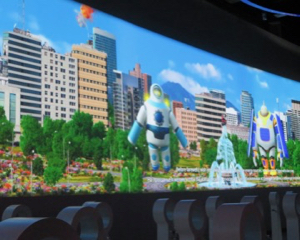 |
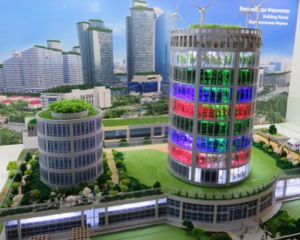 |
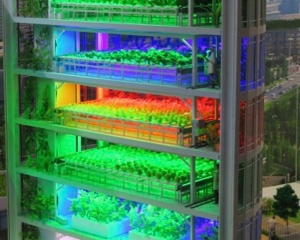 |
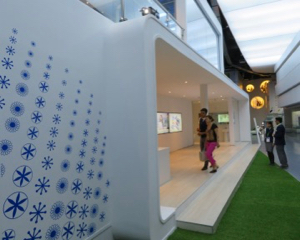 |
|
The Expo 2017 pavilions often offered guests short films, sometimes as animated shows about energy. |
Here a model shows urban agriculture done in a centralized hydroponic farm. |
The vision of dense urban agriculture done in a centralized dedicated verticlal farm building. |
The smart apartments of the future where appliances conserve energy. |
|
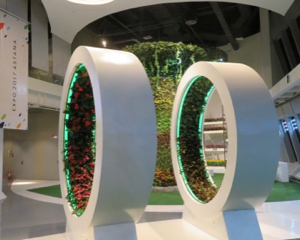 |
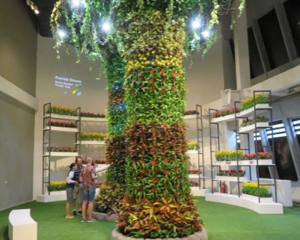 |
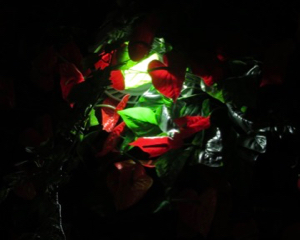 |
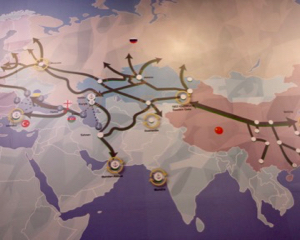 |
|
I never did figure out why indoor hydroponic agriculture might grow crops in loops like this. I just guess it is some sort of a space maximizing technique. |
In the First Thematic Pavilion we saw walls of plants growing indoors. |
Plants growing indoors on walls and near the ceiling offer some intriguing visual images. |
This is a large map in the Kazakhstan Railway exhibit showing Kazakhstan’s role in Europe-Asian transportation networks. The general idea is that the passes through mountains from China into Tajikistan, Pakistan, and India are not suitable, but the existing lines into Kazakhstan work well. |
|
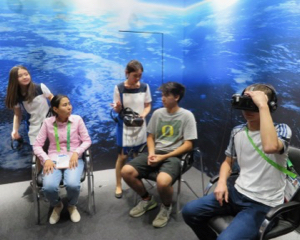 |
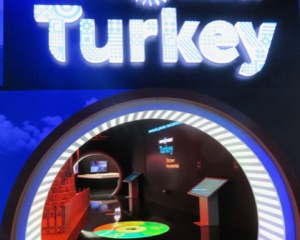 |
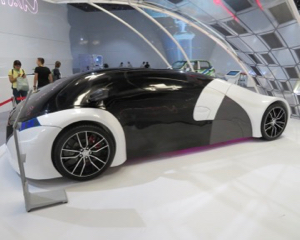 |
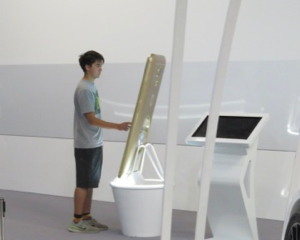 |
|
Whenever possible we tried out the immersive 3-D virtual reality experiences. |
We visited most of the national pavilions, but there were still dozens of places we had not visited. |
The Uzbekistan pavilion emphasized high-technology and displayed this concept car. |
Arthur tries out a giant calculator. |
|
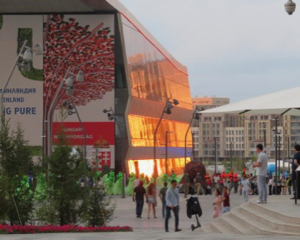 |
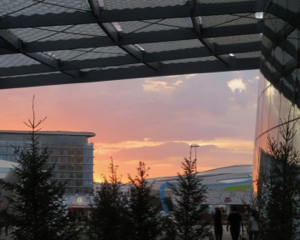 |
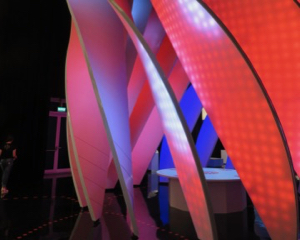 |
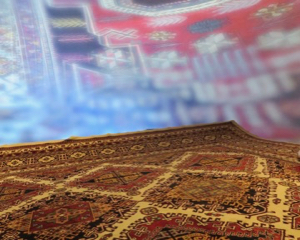 |
|
The soft light and cooling temperatures that arrived around 9:00 to 10:00 were always welcome after the hot days. |
Sunsets gave us some good feelings at the end of a day of learning about future energy and various countries. |
The exhibit of Georgia emphasized the delicious wine of Georgia. |
The Azerbaijan exhibit included a room where we could sit on a massive carpet, and then a film simulated flight, and vents blew wind on us, as if were flying over Azerbaijan on a flying carpet. Very cool. |
|
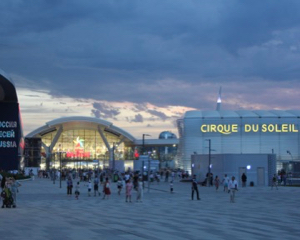 |
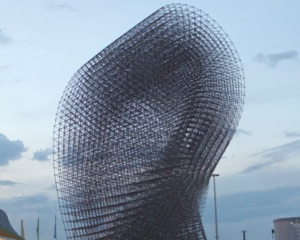 |
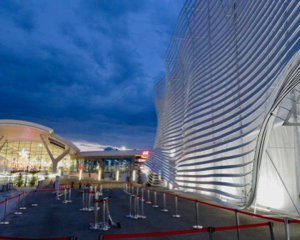 |
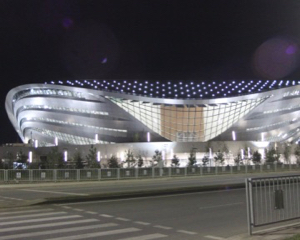 |
|
I had hoped we would see a Cirque du Soleil show in Astana, but we never had the time, and there was no information about tickets or show times. |
One of the many sculptures on the grounds of Expo 2017. |
Walking past the Cirque du Soleil pavilion on our way toward the Mega Silkway Mall. |
Another futuristic building in Astana. |
|
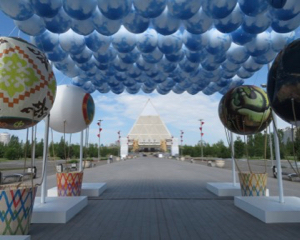 |
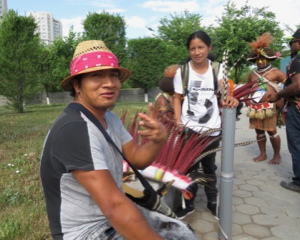 |
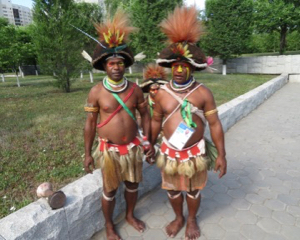 |
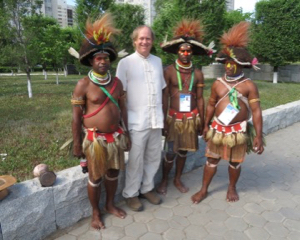 |
|
Looking at the Palace of Peace and Reconcilliation from a balloon pavilion. |
A musician from Ecuador was hanging out in the park near Independence Square. |
These guys from Papua New Guinea were also in the park. |
I posed with the guys from Papua New Guinea. Very friendly people. |
|
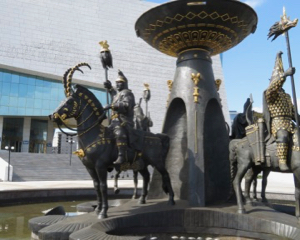 |
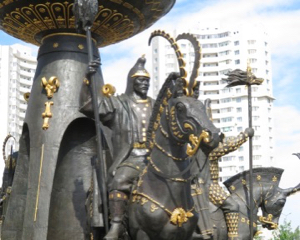 |
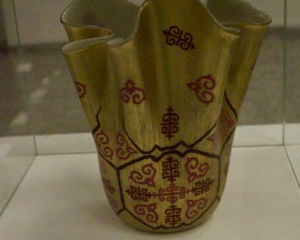 |
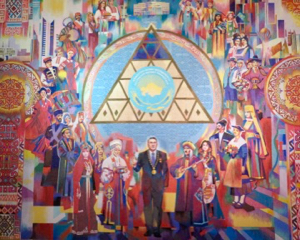 |
|
Fountain with statues at the National Museum of the Republic of Kazakhstan. The costumes represent archeological finds made by Soviet archeologists in the 1960s and 1970s. Originals upon which these costumes on these statues are based are exhibited inside the museum. There has been very little archeology in Central Asia in the past 30 years, so not much has been added to our knowledge of the nomadic peoples who lived in what is now Kazakhstan from 2000 BC to 500 AD. There were three main groups: Indo-European peoples such as the Cimmerians, Sakas, Scythians, Sarmatians, and Indo-Aryans (who made it into India around 1500 BC). Later, there were the Turkic peoples (including of course the Kazakhs). And, there were Mongols. |
I think the guys portrayed in these statues were actually Sakas (relatives of the Scythians, Indo-Europeans who might be considered proto-Persians). The Kazakhs are Turkic. But, probably, the Kazakh culture involved linguisitic and culture changes and intermarriage, not the total displacement of the earlier Indo-European peoples of Central Asia. That is, the Kazakhs (and Turks, for that matter) say they are Turkish, and genetically and linguistically this is correct, but they probably are also Indo-European and genetically related to Persians, North Indians, and Russians (just as most Turkish people in Turkey are probably genetically closer to Greeks and other Mediterranean Indo-Europeans than Asiatic Turkish people). |
The National Museum of the Republic of Kazakhstan has some good collections of art and crafts. Some of it is quite old, but some is recent. This vase by George Spezamonti is from 2017. |
This optimistic and colorful woven tapestry envisions Kazakhstan as a bright and cheerful multiethnic state were people are happy and harmonious. |
|
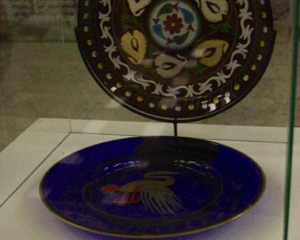 |
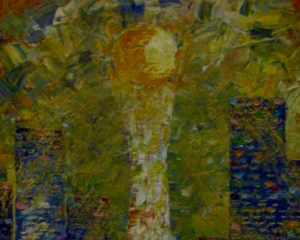 |
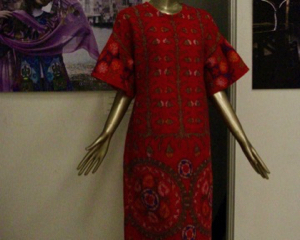 |
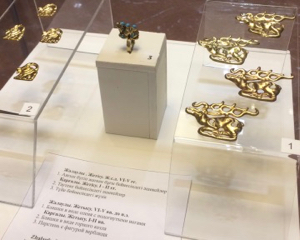 |
|
A dish by George Spezamonti, also from 2017. |
Svetlana Kosta painted this in 2016, and calls it Sun of The New City. |
The National Museum also has some examples of current Kazakh fashion. |
Most famous in the National Museum is the gold, like these deer figures from the 6th to 5th centruy BC, the goat figures from the 1st or 2nd century AD, and the finger ring with a camel. |
|
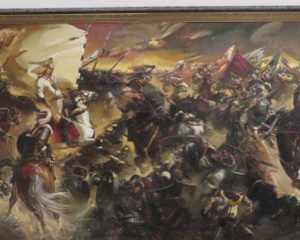 |
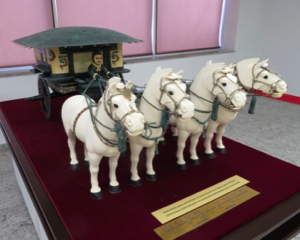 |
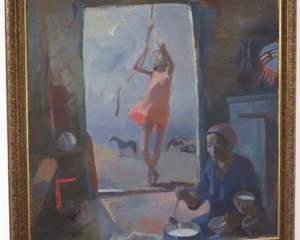 |
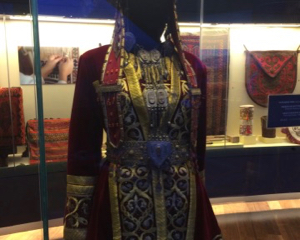 |
|
A painting in the National Museum portraying warfare. |
A fourth century BC Chinese chariot for Emperor Qin Shi Huang. |
The 1987 oil painting “Kymyz” by Bakhtiyar Tabiyev (1940-1999) |
Kazakh traditional dress displayed in the National Museum. |
|
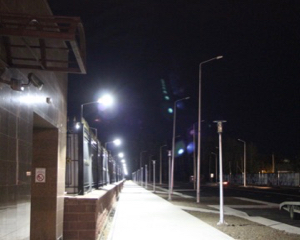 |
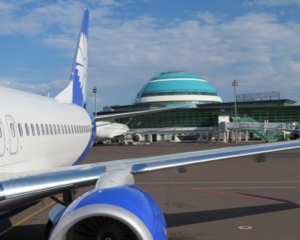 |
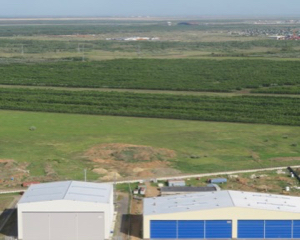 |
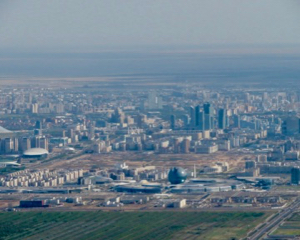 |
|
Late night on a new sidewalk along a new street in Astana. |
A view of the older terminal from the stairway to our Belavia airplane. |
A view of the flat steppe from our airplane as we take off from the Astana airport. |
Astana with the Orb of the Expo center visible in front of the city. |




































































































































































































































